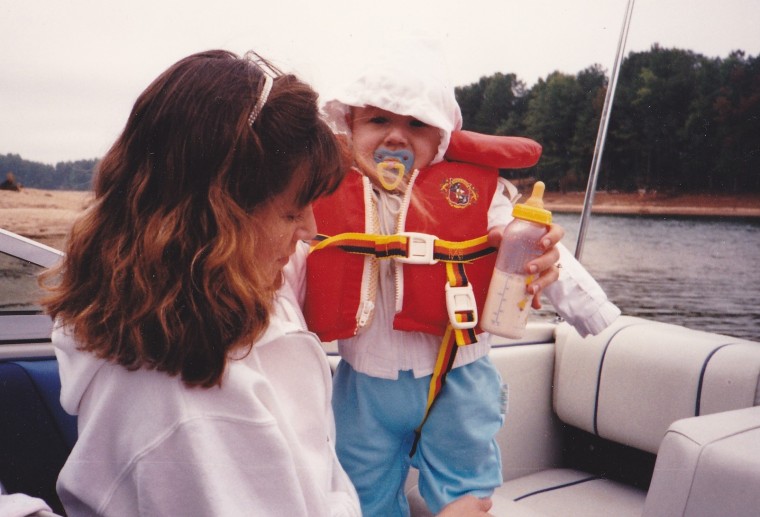Giving birth is not for the faint of heart. Most moms would agree that the unknowns of childbirth can be frightening and intimidating, which is why we turn to doctors, midwives and those with experience to guide us through.
But imagine if you were left to deliver on your own without any sort of professional help? Would you know what to do?

Jennifer Slater found herself in this exact predicament in 1990. After an unusually short birth with her first child, her second son, David, came at an even more staggering speed.
“I always heard second babies can come faster because your body is ready for it,” remembers Slater, a mother of three from Boston.
“But with David, I went into labor and we couldn’t get out of the house fast enough. We were gone five minutes when the baby was born and still had seven minutes before we would arrive at the hospital.”
Left with no other option, Slater was forced to do what many of us never consider: deliver her baby on her own in the back of the family car while her husband pummeled down the highway.
In her new book, "En Route Baby: What To Do When Baby Arrives Before Help Does," Slater compiles anecdotes and tips on what you should do if find yourself in a similar situation.
“When I felt the baby coming, my husband asked if he should pull over. I told him to keep driving towards the hospital, so he put on the emergency flashers and started honking the horn,” she recalled.
Slater was understandably terrified, especially when her son didn’t come out crying. But this once-in-a-lifetime scare for her sent her on a mission to educate others.
“Women don’t want to know what to do because it scares them,” says Slater. “But in almost every single story, whether it’s the dad or the grandmother or even the mother who delivers, probably 60 to 70 percent end up delivering on their own before the ambulance arrives. Knowing what to do decreases this fear.”
San Francisco-based OB/GYN Dr. Laurie Green says second deliveries like Slater’s can occur significantly quicker than a mother’s first labor.
“The average labor for a first-time mom experiencing contractions five minutes apart is around 12 hours,” explains Dr. Green. “For a second-time mom, it’s six hours.”
That sounds like enough time to get yourself to the hospital, but for many women, including Slater, the labor is significantly shorter.
Should you find yourself in a situation similar to Slater’s, “En Route Baby” offers several tips on what you should do. Dr. Green reviewed the advice for TODAY Moms and added some comments of her own.
- If your baby doesn’t start crying right away, your first concern should be to clear the air passages and conduct infant CPR if necessary.
- If the baby’s umbilical cord is wrapped around his or her neck, use your pinky to slide the cord away from the baby’s head face-first so as not to tighten it around the back of the neck. Adds Dr. Green, “if it tears, grab the part closest to the body and pinch it hard, then tie it with whatever is handy, a shoelace, etc.”
- Babies can be affected by hypothermia the minute they are born. Make sure you warm the baby with blankets and towels immediately after birth by covering the baby’s head and putting the baby on the mother's skin right away.
- And finally, if a baby is born still in the amniotic sac, carefully tear the sac in front of the baby’s nose and mouth first to allow the baby to breathe, then pull the rest of the sac off the baby.
“When I started interviewing parents to find similarities on what causes these super-fast labors, I found there weren’t any,” explains Slater.
“Everything that I thought would be a hint for one woman would turn around and be completely different for the next. It’s so hard to predict if it might happen but it’s so easy to read the steps and be prepared. I always tell dads that it takes less time to read my steps on childbirth preparation than it takes to read the instruction manual on your plasma TV!”
Dr. Green also suggests that routine prenatal appointments, especially during the last four weeks of pregnancy, are critical for a healthy birth.
“Someone competent should be checking the cervix weekly the last four weeks of pregnancy. If a cervix is really dilated and thin and the head is against it, it may be best if the mother lives a distance from the hospital that she simply come in and be induced,” Dr. Green said.
But if you find yourself on the side of the road, waiting for the ambulance to arrive, Slater hopes her experience will help guide you through a successful delivery of your own.
“The babies born this quickly are fine, they just need help,” says Slater. “My goal is to decrease the anxiety and fear associated with childbirth.”